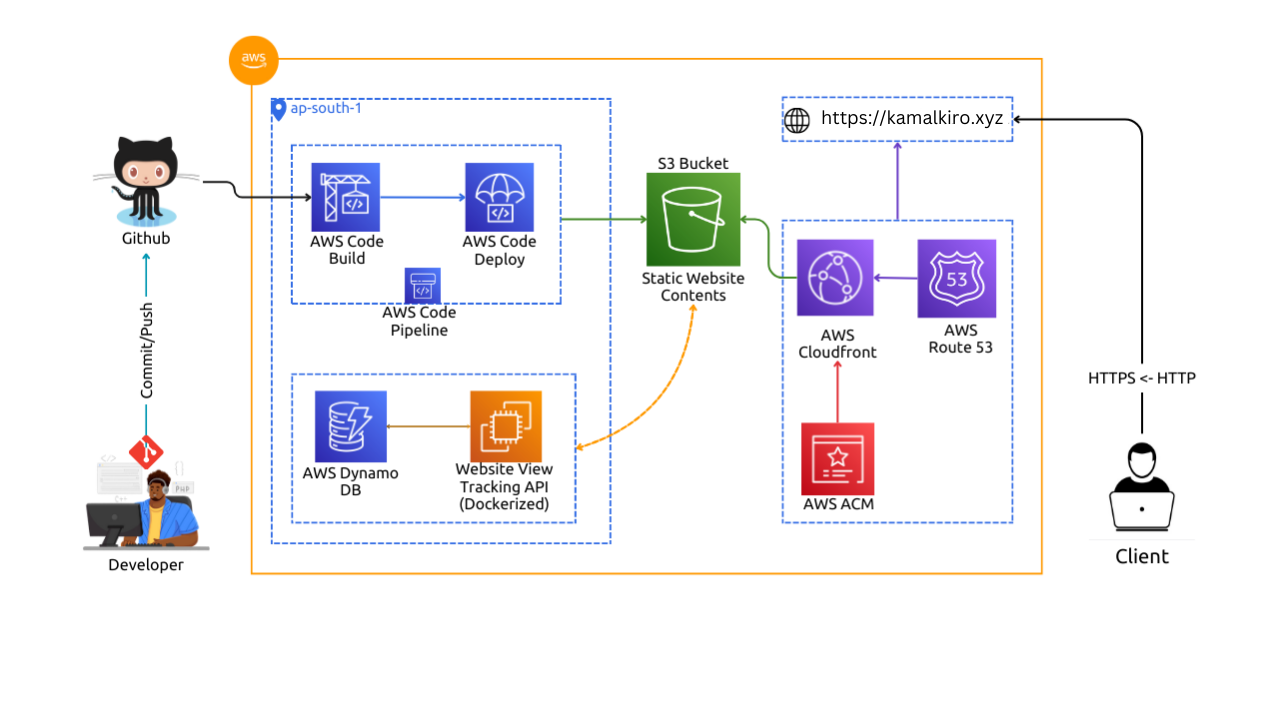Project Overview
Objective:
Developed a professional resume website hosted on AWS, utilizing various AWS services for enhanced performance, scalability, and security.
Key AWS Services Used:
- Amazon S3 for static website hosting
- AWS CloudFront for content delivery
- AWS Certificate Manager (ACM) for SSL/TLS
- AWS Route 53 for DNS management
- AWS DynamoDB for data storage
- AWS CodePipeline, CodeBuild, and CodeDeploy for CI/CD automation
- AWS IAM for secure access management
Website Development & Hosting
- Built a static resume website using a Bootstrap template.
- Hosted the static content on an S3 bucket named after the domain.
- Configured static website hosting and uploaded website files.
Issue: Initial 403 error occurred when accessing the website.
Cause: Missing bucket policy permissions.
Solution: Defined a bucket policy to allow public read access while noting the security implications.
CloudFront Integration for Performance & Security
- Integrated AWS CloudFront as a Content Delivery Network (CDN) to improve performance through caching at edge locations.
- Generated an SSL certificate via ACM (in the N. Virginia region) to enable HTTPS.
- Updated the S3 bucket policy to restrict direct access, allowing access only through CloudFront.
DNS Management with AWS Route 53
- Created a hosted zone for the domain.
- Added name servers to the domain register.
- Created an A record (Alias) to point the domain to the CloudFront distribution.
CI/CD Pipeline for Frontend Deployment
- Configured a GitHub Actions workflow to automate website deployment to the S3 bucket.
- Stored AWS credentials as encrypted GitHub secrets.
GitHub Actions Workflow:
name: Push to S3
on: [push]
jobs:
deploy:
runs-on: ubuntu-latest
steps:
- name: Checkout
uses: actions/checkout@v4
- name: Setup AWS CLI
uses: aws-actions/configure-aws-credentials@v4
with:
aws-access-key-id: ${{ secrets.AWS_ACCESS_KEY_ID }}
aws-secret-access-key: ${{ secrets.AWS_SECRET_ACCESS_KEY }}
aws-region: ${{ secrets.AWS_REGION }}
- name: Sync files to S3
run: |
aws s3 sync ./website s3://yourdomain.com --delete
View Tracking API Development
- Developed a View Tracking API using Go with the Gin framework.
- Integrated AWS DynamoDB for storing and retrieving view counts.
API Functionality:
On a GET / request, the API increments and retrieves the current view count.
Docker Containerisation:
Containerised the API using Docker for easy deployment.
Dockerfile:
FROM golang:1.22
WORKDIR /app
COPY go.* ./
RUN go mod download
COPY . .
RUN go build -o /view-tracker
CMD ["/view-tracker"]
BuildSpec.yml File:
version: 0.2
env:
parameter-store:
DOCKER_USERNAME: docker_username
DOCKER_PASSWORD: docker_password
DOCKER_URL: docker_url
phases:
build:
commands:
- cd tracker_api/
- echo $DOCKER_PASSWORD | docker login -u $DOCKER_USERNAME --password-stdin $DOCKER_URL
- docker build -t "$DOCKER_USERNAME/view_api_img:latest" .
- docker push "$DOCKER_USERNAME/view_api_img:latest"
post_build:
commands:
- echo "Successfully pushed to Docker Hub"
artifacts:
files:
- '**/*'
name: my-artifact
Deployment Automation with AWS CodeDeploy
- Created CodeDeploy applications and deployment groups.
- Installed the CodeDeploy agent on the EC2 instance.
- Utilised IAM roles for secure communication between CodeDeploy and EC2.
- Pulls the new Docker image from Docker Hub.
- Stops the old container.
- Starts the new container.
AppSpec.yml File:
version: 0.0
os: linux
hooks:
ApplicationStop:
- location: scripts/stop_container.sh
timeout: 300
runas: root
AfterInstall:
- location: scripts/start_container.sh
timeout: 300
runas: root
Common Issues & Resolutions
- CodeDeploy Agent Connection Failure
- Error: CodeDeploy agent couldn't receive lifecycle events.
- Solution: Restart the agent and verify IAM role permissions.
- AWS CodePipeline Role Authorisation Failure
- Cause: Insufficient permissions for accessing S3 artifacts.
- Solution: Updated IAM policy to allow artifact access.
- CloudFront Cache Invalidation
- Issue: Website didn't reflect recent changes due to caching.
- Solution: Manually invalidated the CloudFront cache.
- Mixed Content Block (HTTP/HTTPS)
- Error: API requests over HTTP were blocked.
- Solution: Implemented Nginx reverse proxy with HTTPS.
Key Learnings & Best Practices
- S3 Bucket Permissions: Always re-enable "Block Public Access" after configuring CloudFront.
- Docker: Understanding the isolation between container and host networks is crucial.
- CloudFront: Cache invalidation is essential during website updates.
- CI/CD: Parameterizing credentials with AWS Parameter Store enhances security.
- Bash Scripting: Simplifies Docker container management.
Unanswered Questions
- Why are Deployment Groups necessary?
- Why must artifacts be uploaded to an S3 bucket in AWS CodePipeline?
